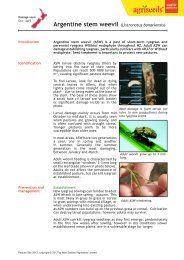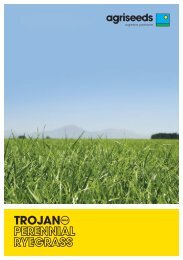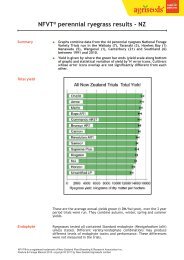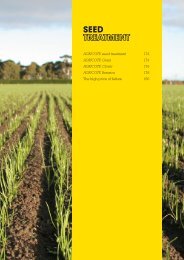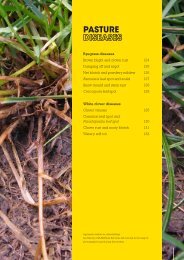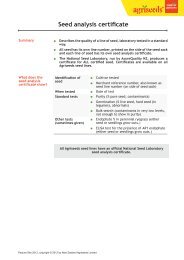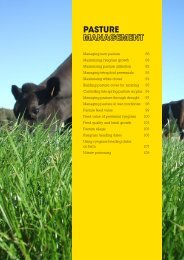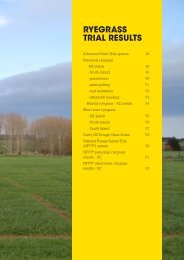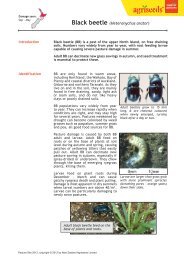Brassica Diseases
Brassica Diseases
Brassica Diseases
You also want an ePaper? Increase the reach of your titles
YUMPU automatically turns print PDFs into web optimized ePapers that Google loves.
<strong>Brassica</strong><br />
Alternaria leaf spot and<br />
bacterial leaf blight 164<br />
Bacterial soft rot and club root 165<br />
Damping off and downy mildew 166<br />
Dry rot 167<br />
Ring spot and viruses 168<br />
Sclerotinia and white blister rust 169<br />
Powdery mildew 170<br />
Picture: Dry rot in swedes
<strong>Brassica</strong> diseases<br />
164<br />
Alternaria leaf spot<br />
and bacterial leaf<br />
blight<br />
Summary<br />
Identification<br />
Importance<br />
Spread<br />
Prevention<br />
and<br />
management<br />
Alternaria leaf spot (ALS)<br />
Two Alternaria fungi, A. brassicae and A. brassicicola, cause these leaf spots on most<br />
brassica species.<br />
A. brassicae causes light brown circular spots with large<br />
yellow margins on leaves in autumn and early winter,<br />
mainly in the South Island. A. brassicicola causes dark<br />
circular spots with narrower yellow margins on leaves in<br />
summer, mainly in the North Island.<br />
ALS reduces leaf efficiency, decreasing crop yield and<br />
feed quality.<br />
ALS spreads via wind-borne spores produced by<br />
lesions on crop residue or weeds. Wet, humid weather<br />
favours spore production. Infected seed can also<br />
introduce infection into a crop.<br />
ALS on kale.<br />
Sowing clean seed minimises infection, along with good<br />
cultivation to work in all brassica crop residue. Grazing<br />
early forage that is becoming infected effectively contains the spread of the disease.<br />
Summary<br />
Identification<br />
Importance<br />
Spread<br />
Prevention<br />
and<br />
management<br />
Bacterial leaf blight (BLB)<br />
The two common bacterial leaf diseases in brassicas are bacterial leaf blight and<br />
Xanathamonas leaf blight (BLB). Both affect a range of crops and have a similar biology.<br />
BLB is typically seen as light brown-black spots with narrow to wide yellow halos.<br />
Pathogens often spread down leaf veins giving them<br />
a characteristic black appearance. Infected leaves<br />
become yellow and die prematurely. Symptoms are<br />
sometimes confused with downy mildew (see page<br />
162).<br />
Damage to leaves can be severe and result in reduced<br />
feed quality and quantity.<br />
BLB survives on weeds and crop debris in the soil.<br />
Warm, wet and windy conditions assist the dispersion of<br />
spores, which enter the host tissue through wounds or<br />
natural openings. Infected seed can also spread BLB into<br />
new areas or crops.<br />
BLB in kale.<br />
Sowing clean seed minimises infection, along with a three year rotation following an<br />
outbreak of the disease. Careful weed control is also recommended, as is keeping pest<br />
populations in check to minimise damage that can become a portal for infection.
<strong>Brassica</strong> diseases<br />
Bacterial soft rot<br />
and club root<br />
165<br />
PASTURE<br />
CULTIVARS<br />
Summary<br />
Identification<br />
Importance<br />
Spread<br />
Prevention<br />
and<br />
management<br />
Bacterial soft rot (BSR)<br />
BSR causes damage as a secondary invader following infection by other pathogens (e.g.<br />
dry rot) or through tissue damaged by insects or weather. It is caused by the bacterium<br />
Erwinia carotovora.<br />
BSR produces a soft, watery light brown-grey rot often<br />
with an unpleasant odour. Although similar to Sclerotinia<br />
infection, no white mycelium are associated with the<br />
damage and no sclerotia are produced.<br />
Under conducive conditions, BSR can cause considerable<br />
additional damage to the original infection or damaging<br />
agent.<br />
BSR is mostly soil-borne and enters the host through rain<br />
splash from wet soil onto damaged areas. It then spreads<br />
by direct plant contact, animal/machinery movement and<br />
by insects.<br />
Secondary BSR of swede<br />
following dry rot infection.<br />
BSR can be greatly reduced by minimising plant damage<br />
and the carry over of host debris. Good crop rotation and<br />
cultivation practices are essential to limit the damage caused by this disease.<br />
RYEGRASS<br />
TRIALS<br />
RYEGRASS<br />
ENDOPHYTE<br />
PASTURE<br />
RENEWAL<br />
PASTURE<br />
MANAGEMENT<br />
PASTURE PESTS<br />
& DISEASES<br />
Summary<br />
Identification<br />
Importance<br />
Spread<br />
Prevention<br />
and<br />
management<br />
Club root (CR)<br />
CR, caused by the fungus Plasmodiophora brassicae, affects most brassicas, causing<br />
galls to form on roots and reducing yield.<br />
Symptoms of CR are plants wilting in the heat of the day and recovering in the evening.<br />
On inspection of roots, infected plants have swollen galls ranging from a few cm in<br />
diameter to the size of a clenched fist. As CR progresses, lower leaves turn yellow<br />
and droop permanently, the plant may die, and yield is<br />
severely affected.<br />
CR is the most destructive disease of brassicas and<br />
severe outbreaks can completely destroy crops.<br />
CR can remain dormant in the soil for many years as<br />
spores. In the presence of susceptible hosts, these spores<br />
germinate, infecting the host through root hairs or wounds.<br />
It survives through weeds such as wild turnip, shepherd’s<br />
purse or hedge mustard.<br />
CR symptoms on roots of<br />
young swedes.<br />
CR can be minimised through good crop rotations,<br />
avoiding multi-cropping of the same cultivar. Good weed<br />
control, good drainage and high soil pH obtained through<br />
liming also limits the development of CR. There are many cultivars with good CR<br />
resistance available on the market.<br />
BRASSICA<br />
CULTIVARS<br />
BRASSICA<br />
MANAGEMENT<br />
BRASSICA PESTS<br />
& DISEASES<br />
SEED<br />
TREATMENT<br />
SEED<br />
INFORMATION<br />
WEEDS<br />
GLOSSARY
<strong>Brassica</strong> diseases<br />
166<br />
Damping off and<br />
downy mildew<br />
Summary<br />
Identification<br />
Importance<br />
Spread<br />
Prevention<br />
and<br />
management<br />
Damping off (DO)<br />
Seedling brassicas can be attacked by DO, which covers a range of fungi that cause plant<br />
death and gaps in establishing crops. Causal pathogens are Pythium and Fusarium spp. in<br />
the North Island, and Rhizoctonia solani in the South Island. Early infections are known as<br />
damping off, while later are known as wire stem. AGRICOTE <strong>Brassica</strong> provides early control<br />
of DO.<br />
Young plants wilt and die from lesions at and below soil<br />
level. Infections of R. solani at later growth stages result<br />
in young plants turning purple and surviving only by<br />
the vascular strands (or wire stem), eventually dying.<br />
Infection is common in second year brassica crops<br />
where gaps in establishment occur.<br />
All the fungi are soil-borne and spores can build up<br />
over successive susceptible crops in the same ground.<br />
Wet, cold conditions are conducive to infection, when<br />
host seedling growth may be restricted.<br />
Seed treatment with fungicides, such as AGRICOTE<br />
<strong>Brassica</strong>, provides early control of damping off. Long<br />
rotations between brassica crops will also reduce<br />
losses.<br />
Gaps in swede stand caused<br />
by DO.<br />
Wire stem in swedes.<br />
Summary<br />
Identification<br />
Importance<br />
Spread<br />
Prevention<br />
and<br />
management<br />
Downy mildew (DM)<br />
DM is caused by the fungus Peronospora parasitica,<br />
which infects seedlings, leaves, flowering stems and<br />
seed pods.<br />
On seedling leaves, DM shows up as black dots and<br />
leaf yellowing and reddening, with purplish grey<br />
sporulation on the underside of leaves. On older<br />
leaves, DM is shown as lesions with leaf yellowing, often<br />
accompanied by black speckling. Affected leaves die<br />
off prematurely.<br />
DM can greatly affect feed quality and yield.<br />
DM can remain in the soil as free living spores or in<br />
trash. In spring, these spores infect leaves, with rapid<br />
build up in mild, moist weather conditions. DM can also<br />
be introduced via infected seed.<br />
Sowing clean seed minimises infection, along with<br />
thorough cultivation and good weed control. Good<br />
crop rotations are also essential, especially in areas<br />
with high levels of DM present. If infection does occur,<br />
grazing affected plants does limit the spread of the<br />
disease within the crop.<br />
DM symptoms on kale leaf.<br />
Early symptoms of DM on<br />
underside of swede leaf.
<strong>Brassica</strong> diseases<br />
Dry rot<br />
167<br />
PASTURE<br />
CULTIVARS<br />
Summary<br />
Identification<br />
Importance<br />
Dry rot (DR)<br />
DR, also known as black leg, is caused by the fungus Leptosphaeria maculans. It can be<br />
extremely destructive in swede, rape and kale crops, and occurs throughout NZ, most<br />
commonly in the lower South Island.<br />
DR appears as small brown lesions on leaves in<br />
summer and autumn. On stems and bulbs, DR<br />
develops into large brown-black dry and cracked<br />
lesions. On stems, black streaking can develop on the<br />
surface tissue. In wet weather, lesions ooze a rose-pink<br />
spore mass. Infected leaves die, bulbs collapse and<br />
stems break at the lesion.<br />
DR can be very destructive, causing 100% crop loss in<br />
some instances.<br />
DR symptoms on leaf of<br />
young swede plant.<br />
RYEGRASS<br />
TRIALS<br />
RYEGRASS<br />
ENDOPHYTE<br />
PASTURE<br />
RENEWAL<br />
PASTURE<br />
MANAGEMENT<br />
Spread<br />
Prevention<br />
and<br />
management<br />
DR over-winters in infected crop residue, and spores<br />
can spread up to 1-2 km following rain. DR enters bulbs<br />
and stems through growth cracks or insect feeding<br />
wounds. Although not common, infected seed can<br />
introduce DR into new areas.<br />
Cultivars with higher DR tolerance should be used in<br />
problem areas, and only treated, certified seed should<br />
be sown. Good crop rotations are essential. Where DR<br />
was noted in a first crop, do not follow up with the same<br />
crop in the second year. Good cultivation is necessary<br />
to ensure full breakdown of crop debris before<br />
resowing.<br />
Advanced DR on swedes.<br />
PASTURE PESTS<br />
& DISEASES<br />
BRASSICA<br />
CULTIVARS<br />
BRASSICA<br />
MANAGEMENT<br />
BRASSICA PESTS<br />
& DISEASES<br />
GLOSSARY<br />
WEEDS<br />
SEED<br />
INFORMATION<br />
SEED<br />
TREATMENT
<strong>Brassica</strong> diseases<br />
168<br />
Ring spot<br />
and viruses<br />
Summary<br />
Identification<br />
Importance<br />
Spread<br />
Prevention<br />
and<br />
management<br />
Ring spot (RS)<br />
RS, caused by the fungus Mycosphaerella brassicicola, occurs sporadically from season<br />
to season.<br />
It produces dark spots scattered across the leaves<br />
with characteristic rings of dark fruiting bodies. Lesion<br />
margins are yellow, and leaf yellowing and early<br />
leaf drop occurs as RS progresses. RS can easily be<br />
confused with Alternaria (see page 164), and needs<br />
microscopic examination to differentiate.<br />
Can be important in some seasons on some crops.<br />
RS overwinters in crop debris, on weeds or volunteer<br />
brassicas. In spring spores are produced, infecting<br />
leaves and seed pods.<br />
Use certified disease free seed to ensure no new source<br />
of infection, while good cultivation and crop rotations<br />
ensure low levels of crop debris and weeds for RS to<br />
over-winter on. Early grazing of infected plants limits the<br />
spread of RS.<br />
Early RS symptoms on kale<br />
leaf.<br />
Summary<br />
Identification<br />
Importance<br />
Spread<br />
Prevention<br />
and<br />
management<br />
Viruses<br />
The three main brassica viruses are beet western yellows virus (BWYV), cauliflower<br />
mosaic virus (CuMV) and turnip mosaic virus (TuMV). All are common in brassica crops<br />
throughout NZ.<br />
BWYV is characterised by colouring in the leaves,<br />
especially purples and reds, eventually turning yellow.<br />
CuMV and TuMV cause similar symptoms (test often<br />
required to differentiate). Infected plants show patterns,<br />
distortion and mottling in the leaves. Infected plants are<br />
stunted and often die if infection occurs early.<br />
Early infection with any of these viruses can cause<br />
severe crop losses.<br />
All are introduced into crops by aphids. The two<br />
main aphid species in brassicas, the green peach<br />
and grey cabbage aphid, are their main vectors. The<br />
main primary sources of these viruses are weeds and<br />
brassica volunteers in the vicinity of the crop.<br />
BWYV on swedes.<br />
The application of aphicides can prevent the introduction of these viruses, however<br />
correct timing is difficult to achieve. Seed treatments can give seedlings up to 6 weeks<br />
protection, often long enough to protect through the critical period when aphids are<br />
flying. Seed beds should also be kept free of weeds and volunteers, especially for<br />
second year crops.
<strong>Brassica</strong> diseases<br />
Sclerotinia and white<br />
blister rust<br />
169<br />
PASTURE<br />
CULTIVARS<br />
Summary<br />
Identification<br />
Importance<br />
Spread<br />
Sclerotinia (SC)<br />
SC, also known as watery soft rot, is a fungal pathogen<br />
with a wide range of hosts including all brassicas.<br />
Infection occurs from air-borne spores or from overwintering<br />
sclerotia (dormant survival spores) in the<br />
soil.<br />
SC is characterised by a soft watery rot of stems and<br />
bulbs. It produces extensive white mycelium under<br />
humid, wet conditions, and black overwintering<br />
sclerotia develop on and in the diseased tissue.<br />
In many crops, only scattered infected plants are<br />
seen. But SC can build up in areas where consecutive<br />
susceptible crops are used.<br />
Sclerotia can survive in the soil for up to 20 years,<br />
and spread by physical contact with infected tissues.<br />
Thus patches of infection can occur in dense moist<br />
crops. Sclerotia are often the same size and shape as<br />
brassica seeds, so contaminated lines can account for<br />
introduction into a crop.<br />
Watery soft rot/sclerotinia on<br />
swedes.<br />
RYEGRASS<br />
TRIALS<br />
RYEGRASS<br />
ENDOPHYTE<br />
PASTURE<br />
RENEWAL<br />
PASTURE<br />
MANAGEMENT<br />
PASTURE PESTS<br />
& DISEASES<br />
Prevention<br />
and<br />
management<br />
Sowing certified disease free seed along with good<br />
crop rotations minimises SC. Good cultivation is also<br />
essential, to ensure that crop debris is broken down<br />
and out of the planting zone when re-sowing into crop.<br />
Sclerotia in kale stems.<br />
BRASSICA<br />
CULTIVARS<br />
Summary<br />
Identification<br />
Importance<br />
Spread<br />
Prevention<br />
and<br />
management<br />
White blister rust (WBR)<br />
WBR is a common fungal disease of weed brassicas that can spread to crops, caused by<br />
the fungus Albugo candida.<br />
White blisters form on the underside of leaves that<br />
produce white spores. Chlorotic spots occur on the<br />
upper leaf surface. Infection of the seed stalk and head<br />
produces twisting and swelling (called 'stag’s head').<br />
Leaf infection can often be found in association with<br />
downy mildew (see page 166).<br />
WBR is uncommon in leafy turnips.<br />
Spores are readily airborne, with cool wet conditions<br />
favouring WBR development. Seedlings are particularly<br />
susceptible. WBR over-winters on volunteers and weeds.<br />
WBR symptoms on underside<br />
of turnip leaf.<br />
Sowing certified seed minimises infection, while keeping weed populations in check<br />
(especially shepherd’s purse) is extremely beneficial. If young crops are infected, a light<br />
grazing may be considered to reduce infection.<br />
BRASSICA<br />
MANAGEMENT<br />
BRASSICA PESTS<br />
& DISEASES<br />
SEED<br />
TREATMENT<br />
SEED<br />
INFORMATION<br />
WEEDS<br />
GLOSSARY
<strong>Brassica</strong> diseases<br />
170<br />
Powdery Mildew<br />
Summary<br />
Identification<br />
Importance<br />
Spread<br />
Prevention<br />
and<br />
management<br />
Powdery Mildew (PM)<br />
PM is caused by the fungus Erysiphe polygoni and is<br />
a common minor disease of brassicas, mostly in late<br />
summer and autumn.<br />
Powdery fungal growth occurs on upper and lower<br />
leaf surfaces. Leaves can become yellow and drop<br />
prematurely.<br />
Sometimes causes damage in summer sown forage<br />
crops when going into winter.<br />
PM resistant (left) vs.<br />
susceptible cultivar (right) .<br />
PM survives winter as a fungus on infected plants,<br />
weeds or crop debris. Air-borne spores produced in<br />
spring can land on susceptible plants, causing new infections. Spores are also released<br />
after rain in autumn.<br />
Normally, no control is required. There are a number of fungicides available which are<br />
effective against PM, if it reaches high levels in high-value crops. The best prevention is<br />
to use PM resistant cultivars.



